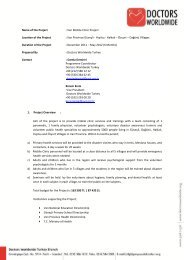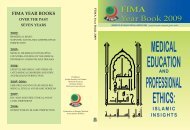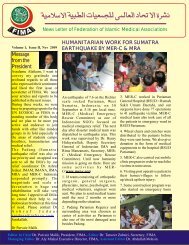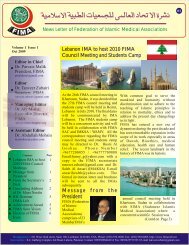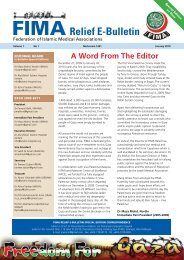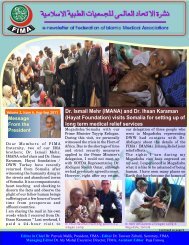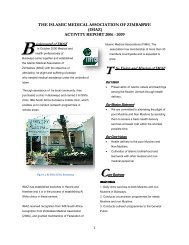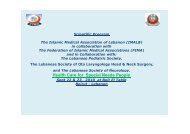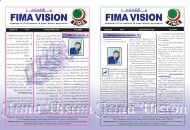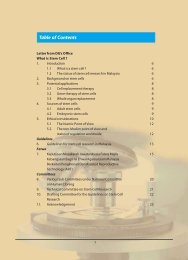FIMA Year Book 2010-2011 - Federation of Islamic Medical ...
FIMA Year Book 2010-2011 - Federation of Islamic Medical ...
FIMA Year Book 2010-2011 - Federation of Islamic Medical ...
You also want an ePaper? Increase the reach of your titles
YUMPU automatically turns print PDFs into web optimized ePapers that Google loves.
<strong>FIMA</strong> SAVE VISION IN NIGERIA<br />
prepared for surgery. Patients are given local<br />
anaesthesia <strong>of</strong> the eye and sent for surgery<br />
which in most cases was extracapsular<br />
cataract extraction with intraocular lens<br />
implantation (ECCE + IOL). After the<br />
surgery, patients were admitted for the night.<br />
5. Post operation<br />
1 st Postoperative Day (POD 1)<br />
Patients are usually seen after the pad has<br />
been removed and the eye cleaned with a<br />
sterile swab. The surgeons will examine all<br />
patients to ascertain the results <strong>of</strong> the<br />
surgeries.<br />
Patients are usually discharged home on that<br />
day, after they are given instructions on how<br />
to take care <strong>of</strong> their eyes and proper use <strong>of</strong><br />
medication which is given for free.<br />
Patients were also informed <strong>of</strong> follow-up at<br />
designated eye clinics within their localities.<br />
6. Follow-ups<br />
Follow up visits are done at 1 week, 3 weeks<br />
and 6 weeks after surgery.<br />
As most <strong>of</strong> secondary institutions (general<br />
hospitals) where the camps were done are<br />
not research oriented, no proper<br />
documentation <strong>of</strong> the results including<br />
postoperative complications. Also there are<br />
lot <strong>of</strong> loss to follow up.<br />
7. Success Rate<br />
As mentioned earlier, no data to ascertain this<br />
but on the average it can be estimated between<br />
75 and 85 percent success rate.<br />
General Remarks:<br />
The commencement <strong>of</strong> activities <strong>of</strong> <strong>FIMA</strong> in<br />
Nigeria has brought a lot <strong>of</strong> relief to the teaming<br />
patients who would have remained blind for<br />
uncertain periods. This has in turn improved the<br />
socio-economic well-being <strong>of</strong> many families.<br />
After the initial camp in Nigeria in 2007, many<br />
sponsors indicated interest and sponsored camps.<br />
However, as <strong>FIMA</strong> largely rely on arrangements<br />
and logistics by sponsors, problems are usually<br />
encountered at the commencement <strong>of</strong> camps,<br />
especially in screening <strong>of</strong> patients and selection<br />
<strong>of</strong> proper surgical candidates.<br />
<strong>FIMA</strong> has shown consistent interest in the camps<br />
in Nigeria and as a mark <strong>of</strong> its appreciation and<br />
recognition; <strong>FIMA</strong> has awarded Plaques <strong>of</strong><br />
Honour to four individual sponsors <strong>of</strong> Eye<br />
Camps in Nigeria. <strong>FIMA</strong> has equally recognized<br />
the efforts and commitment <strong>of</strong> some individuals<br />
and has given them honorary appointments such<br />
as The National Patron <strong>of</strong> <strong>FIMA</strong> activities in<br />
Nigeria (Engr Maimaje Ibrahim Abdullahi), The<br />
International Coordinator <strong>of</strong> <strong>FIMA</strong> Activities in<br />
Nigeria (Mr Yusuf Umar Chedi) and National<br />
Coordinator <strong>of</strong> <strong>FIMA</strong> Activities in Nigeria (Dr<br />
Imam Wada Bello). Also through <strong>FIMA</strong>, some<br />
<strong>of</strong> the sponsors have purchased the following<br />
equipments for the success <strong>of</strong> the eye camps in<br />
Nigeria.<br />
1. Ten operating microscopes.<br />
2. Two keratometers.<br />
3. Two A-Scan ultrasound devices.<br />
4. Slit Lamp.<br />
5. Hot air oven.<br />
Suggested future improvements include proper<br />
documentation <strong>of</strong> follow up visits, change in<br />
type <strong>of</strong> surgeries <strong>of</strong>fered toward sutureless<br />
techniques (small incision cataract surgery or<br />
phaco emulsification) which increase intraoperative<br />
safety and decrease post-operative<br />
suture related complications and need for<br />
glasses 7 . And finally, more concentration is<br />
needed on capacity building through increased<br />
training <strong>of</strong> Nigerian ophthalmic practitioners<br />
which will make the country self-dependant in<br />
managing cataract patients.<br />
References:<br />
1. UN estimate 2008<br />
(http://data.un.org/CountryPr<strong>of</strong>ile.aspxcrName=NI<br />
GERIA)<br />
2. HDI <strong>2010</strong> Index - Human Development Report<br />
Office - United Nations Development Programme.<br />
3. Causes <strong>of</strong> blindness and visual impairment in<br />
Nigeria: the Nigeria national blindness and visual<br />
impairment survey. Abdull MM et al. Invest<br />
Ophthalmol Vis Sci. (2009);50:4114–4120<br />
4. Annual Report <strong>of</strong> Nigerian Ophthalmic Nurses<br />
Association 2009<br />
5. Rabiu MM. Cataract blindness and barriers to<br />
uptake <strong>of</strong> cataract surgery in a rural community <strong>of</strong><br />
northern Nigeria. Br J Ophthalmol 2001;85:776–<br />
780.<br />
6. Howard V. Gimbel and Albena A. Dardzhikova.<br />
Consequences <strong>of</strong> waiting for cataract surgery.<br />
Current Opinion in Ophthalmology <strong>2011</strong>, 22:28–30.<br />
<strong>FIMA</strong> <strong>Year</strong><strong>Book</strong> <strong>2010</strong>-<strong>2011</strong><br />
89




